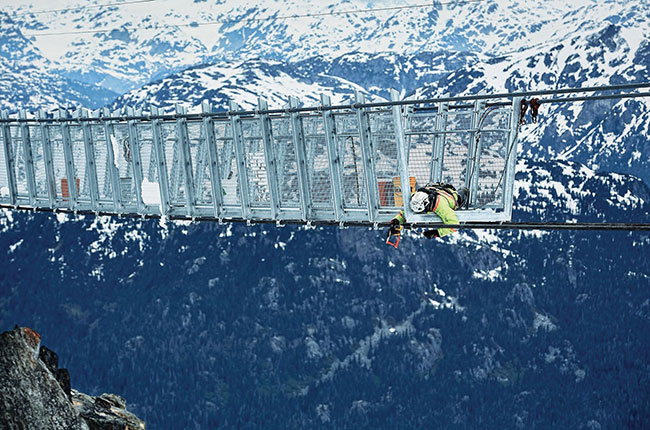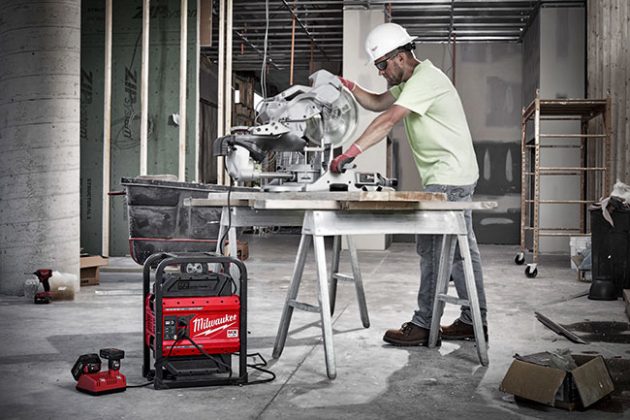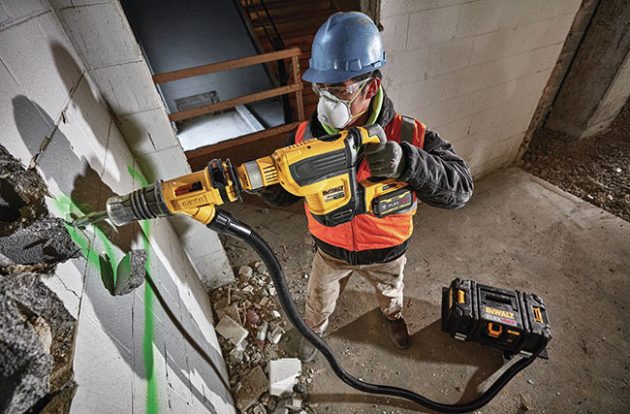
Cut the cord on work hazards
By Andrew Snook and Daniel Reale-Chin
Features Tech tipsCordless technology is driving safety improvements
 Manufacturers are constantly working on improvements to cordless tools with user safety in mind.
photo Courtesy of DeWalt
Manufacturers are constantly working on improvements to cordless tools with user safety in mind.
photo Courtesy of DeWalt It’s no secret that working in the construction sector comes with its own set of worksite hazards. Since 2006, the construction industry has been sitting at number three on the leaderboard for the most lost-time claims in Canada.
According to the Association of Workers’ Compensation Boards of Canada, 2019 lost-time claims in Canada totalled 271,806. Of those, 28,111 claims were in the construction sector, behind only health care and social assistance (49,118 claims) and manufacturing (36,432 claims).
To put that into perspective, the construction sector had more lost time claims in 2019 than agriculture, forestry, fishing, hunting, mining, quarrying, oil and gas extraction and the wholesale trade combined (26,689 claims).
When those 271,086 claims are broken down by “event or exposure,” contact with objects and equipment account for 62,035 claims, while falls account for 55,139 claims, and exposure to harmful substances or environments account for 18,351 claims. All these types of risks are certainly prevalent in the construction sector.
Trips and falls
The sheer number of power tools moving to cordless battery technologies these days will certainly assist with a reduction of workplace injuries due to trips and falls caused by extension cords that, not long ago, could be found sprawled across busy job sites.
“From the outlet to the area where the trades person was working was a trip hazard the entire way because of the extension cords being tied from one to another, which caused not only trip hazards but also fraying and the potential for electrical shock,” says Brent Neilly, group marketing manager for core trades at Milwaukee Tool. “By having a cordless jobsite, you’ve now removed all of those potential trip hazards and the jobsite is a lot cleaner from the power outlet to the user.”
User control
Keeping the user in control of their tool not only keeps workers on task but helps to provide protection particularly in drilling and cutting applications where jams may occur. To reduce the likelihood of bind-ups, manufacturers are now building clutch reducing technology into heavy-duty drills.
“The systems detects the motion of the tool and will shut it down in bind-up situations, helping to minimize sudden torque reaction compared to standard clutches,” says Richard Cacchiotti, director of product development, commercial products for DeWalt. “In addition, some tools like grinders now feature a brake that stops the wheel when a pinch is detected. Also, integrated solutions like lanyards are a simple way that allow users to tether tools to rigid structures while they’re working at heights. So the user can secure the tool in case it is dropped.”
Engineering controls
Once power tool manufacturers started focusing on the production of cordless products, the OEMs started to realize that they could implement more technologies into the products that weren’t offered on AC powered corded tools. Many of these engineering controls are designed to protect the user from injury.
“A lot of the tools coming out right now have a ton of force and a ton of torque, so when they catch or snag onto something its first inclination is to take the user for a ride. When making a purchasing decision, contractors should look for cordless threading tools and cordless rotary hammers that are built with some sort of auto-stopping technology,” Neilly says.
These added technologies have also allowed for the replacement of many typical handheld power tool applications with cordless applications that can lead to a better long-term quality of life for tradespeople. Features like anti-vibration technology in rotary hammers can allow the user to work longer while helping prevent white knuckle syndrome, which can lead to arthritis.
“Today you’ll find that most tool makers now incorporate vibration-reduction systems in equipment like rotary and demolition hammers, which are some of the biggest contributors to hand/arm vibration exposure,” says Cacchiotti. “Mechanisms are now built into tools to help reduce vibration felt at the handles with the purpose of having the tool absorb the shock, rather than the user. Using the rotary and demolition hammer as the example, you will now typically see a small rubber accordion covering the handles, an internal counterbalance weight, or a free-floating mechanism/motor. Both the counterbalance and free-floating mechanism are internal to the tool and seamless in the design.”
“This reduces a lot of the repetitive stress injuries for somebody working in the trades for 30 to 40 years using the same tool day-in and day-out,” Neilly says.
To help ensure that power tools are operating safely and reduce the risk of malfunctions on a jobsite, some OEMs have developed apps where the user can track when their tool requires any sort of annual maintenance or regular servicing.

Improved tools offer better user control and engineering control for safety.
Photo courtesy of Milwaukee
Removing the unseen hazards
With cordless tool adoption steadily on the rise for handheld power tools, the current target in OEM’s crosshairs is the replacement of gas-powered light equipment with battery-powered tools and equipment.
“We’re getting to a point where it’s going to be a carbon-free jobsite. People are interested in having their job sites completely emission free, removing gas generators from sites,” Neilly says. “One thing that isn’t talked about is the human sustainability element. Workers want to go home the same way they arrived. But more importantly, when they retire, we want them to have a higher standard of living and emission-free cordless products and added safety features help accomplish that.”
By switching to battery power for tools like a 14-inch concrete saw or power source instead of a generator, the user can use these tools inside a building that doesn’t expose the user to potentially harmful emissions or a lot of noise.
Another major unseen hazard that some of the latest power tools are helping tackle is dust control, which is a major concern for tradespeople across the country. Silica dust from concrete poses the biggest concern as prolonged exposure can lead to acute, chronic or accelerated silicosis, an incurable lung disease that causes a wide variety of health issues ranging from fatigue, extreme shortness of breath, chest pain, respiratory failure, weight loss and death.
According to the Canadian Centre for Occupational Health and Safety website:
CAREX estimates that approximately 380,000 Canadians are occupationally exposed to silica; 93 percent of these workers are male. The largest occupational groups exposed to silica were construction trades labourers, heavy equipment operators, plasterers and drywallers.
The activities listed that tend to generate the greatest risk of exposure to silica dust were abrasive blasting, cutting, sawing, demolishing, drilling, grinding, jackhammering, milling, mixing, polishing, roofing, sanding and sweeping.
“Capturing dust before it is emitted into the air has three benefits: it reduces the amount of airborne silica particles that users can potentially inhale, increases user visibility for safe, uninterrupted work, and cuts down on tool maintenance costs from prolonged wear and exposure to particles,” says Cacchiotti.
Fortunately, OEMs have been designing dust-management systems to help reduce exposure on jobsites.
“Manufacturers are making it a priority to not only focus on dust extraction equipment, but the application as a whole, including the tool, accessory and extractor to create a seamless, easy-to-follow system,” Cacchiotti says.
“Ensure you use a complete dust-management system. It used to be that you’d drill holes and cut concrete without a whole lot of interest in what you’re drilling. Now we found there’s a lot of airborne silica, so OEMs designed solutions to reduce the amount of airborne silica on site,” Neilly says.
These solutions come in the form of vacuums that are attached to tools like rotary hammers, and water-based solutions that dispel water while the user is drilling and cutting to reduce the ability for silica to become airborne.
“Look for a 99.9-percent HEPA rating to remove 99.9 percent of airborne silica,” Neilly says.

Going cordless won’t rid all hazards, but it can help with trips. and falls.
Cordless challenges
One of the biggest roadblocks to replacing light equipment on job sites is battling user perception when it comes to battery-operated equipment.
“There’s still some perception that cordless can’t replace those corded or gas-powered units. We just need the opportunities to do head-to-heads to show power, value and savings of cordless tools” Neilly says.
Power tool safety 101
Additional ways some OEMs try to keep worksites safer is through education on the use of cordless power tools.
“The actual utilization of tools starts at a grassroots level at union centres and training centres. Our field teams will go in and do Safety 101 courses with our power tools,” Neilly says.
Another way to ensure safe use of power tools is to read the manual before operation – a simple but important solution.
“The biggest thing is to read the manual. A lot of the time, the complaints we get about power tools can be alleviated by the safety benefits we put into the tools, but some people don’t know that because they haven’t read the manual,” Neilly notes.
Print this page
Leave a Reply